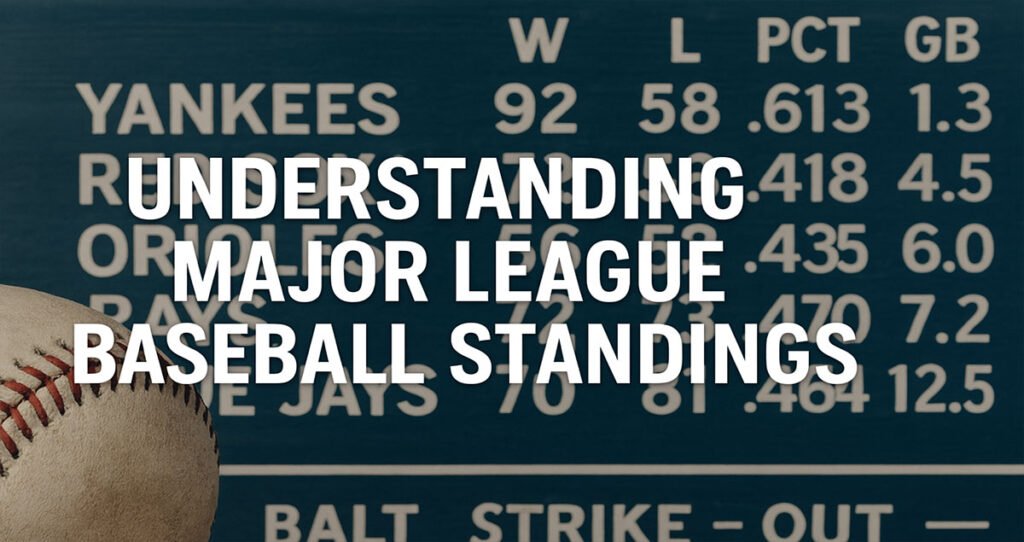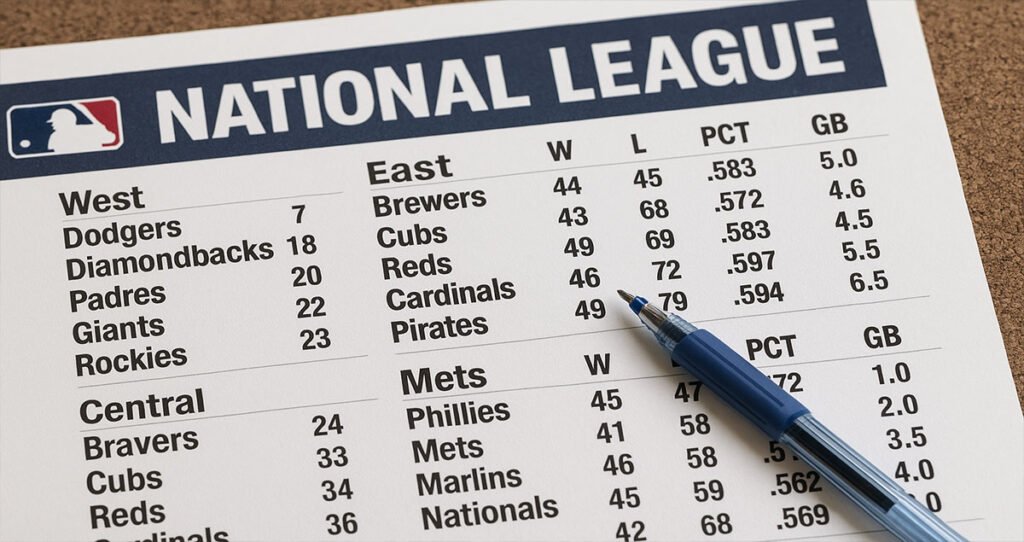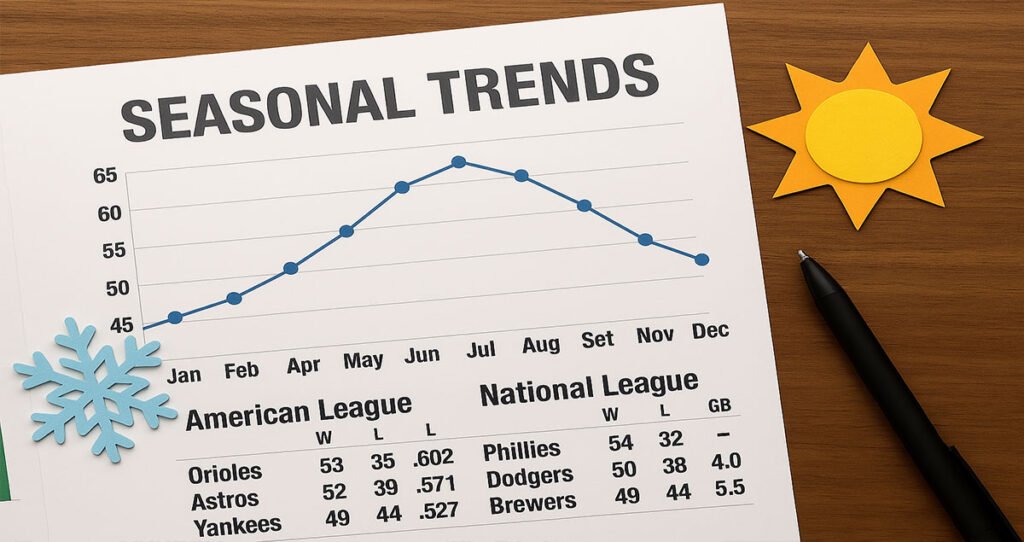The MLB standings can be considered as some potent business intelligence tools that can enhance 10X smarter planning outcomes. Businesses can use the baseball standings data to find trends, grasp market situations, and make their choices based on compelling performance data in real-time. The overall representation of team scores, playoff positions, and competitor positions creates significant meanings that can be used in business planning, resource utilisation, and strategy forecasting.
Introduction to MLB Standings
The standings of Major League Baseball are more than the field records of wins and losses. They give a detailed analysis of performance measures, competitor location, as well as strategy, which goes way beyond the diamond. Intelligent CEOs realize the fact that baseball standings can be used in ascertaining the dynamics of a market, allocation of resources, and tracking mechanisms of performance.

The MLB standings concept brings into play a number of factors, such as the division standings, playoff position, and wild cards. These factors are reflections of business situations where firms are in competition over market share, industry leadership, and in the search for ways to grow and expand. The operation of major league standings gives businesses the idea of coming up with their own set of performance measurements.
Businesses nowadays can use the classified method of baseball standings to design a more successful business plan. The habitual monitoring of the performance of the teams in the long term provides information on consistency, flexibility, and strategic implementation. The firms that pursue comparable approaches usually learn how to make better decisions and how to position themselves better on the market.
Analyzing data concerning the standings, professional baseball organizations invest many resources to make relevant decisions concerning the acquisition of players, planning, and distribution of resources. The same analytical technique can be used in a business scenario and assist in measuring the outcomes of organizations so that better results can be achieved using statistical data.
Understanding Major League Baseball Standings
Major League Baseball standings give a total picture of the performance of individual teams in various aspects. The system of rankings in the MLB league follows a series of wins and losses, percentages of wins and losses, games trailing position, and other performance measures, a cumulative collection of which demonstrates a portrait of a competitor. This cross-dimensional method of performance measurement presents useful insights to business organizations that aim to develop their own performance measurements and assessment systems.

The format of the baseball standings shows the intricacy of the contemporary competitive realities. Scoring applies even as teams in a division seek to win division titles, they are also assessed on the same performance criteria as the rest of the league. The two-tier assessment framework is a reflection of the fact that enterprises have to perform not only in their chosen market niches but also compete favorably in the larger business environment.
To get the complexity of MLB standings, it is important to consider short-term results as well as long-term overall strategies. The teams that are always positioned higher in standings usually have a better ability to plan strategically, manage, and execute their resources. The same thing can be said about business communities in which long-term success involves tactical brilliance as well as strategic values.
Its availability and clarity in the access of baseball standings data make the latter very important in business analysis. Contrary to most corporate performance measures, which are kept confidential, MLB standings are open and available to all, and it is updated on a regular basis, which means that the current state of rivalry and performance patterns can be seen instantaneously to make business decisions.
The Power of Data-Driven Decision Making
Data-based decision making is a paradigm change in the manner in which organizations are doing strategic planning and managing operations. The MLB standings system is one of the examples of this strategy because it has real-time data on all aspects of it, which allows making informed decisions on different levels of an organization. When companies adopt comparable data-driven practices, their business executives enjoy vast advances in planning accuracy, as well as strategic results.
The most explicit and logical way of collecting and analyzing performance information, such as standings in baseball, helps organizations define the patterns, trends, and opportunities that would have in other circumstances gone unrewarded. This method of analysis enables companies to move out from intuitive decisions to evidence-based strategic planning that gives a more predictable result, which is also more sustainable.
The data included in baseball standings covers all the diverse execution markers, such as winning and losing games, runs scored, runs permitted, and numerous other information focuses that are utilized to grant a clear picture of the execution of the team. In a related fashion, firms may also engage in the creation of more holistic systems of performance measurement that can measure key indicators on a variety of dimensions and in a more fine-grained way, thus permitting a more in-depth and precise understanding of the health of the organization and the competitive standing that it has.
MLB standings reflect the dynamic challenges inherent in a sporting environment since their updates are made in real-time. The companies that have such real-time monitoring systems in place will be able to react faster to the changes in the market, threats of competition, and the opportunities that emerge. Such a swiftness of response capacity would frequently translate into escalated business performance and a competitive edge.
American League Standings Analysis
The American League standings give a lot of opportunity to understand the dynamics of competitions in one of the major competitive leagues in the sphere of baseball. The comprehension of AL East standings, AL Central standings, and AL West standings allows seeing the influence of geographical closeness, distribution of resources, and convenient orientation on rivalry results. These lessons are easily applicable to business terms where regionalism as well as market segmentation is an important aspect.
The peculiarity of American League baseball standings is that they show the necessity to consider the performance of the division, but keep in mind the bigger picture competition. To qualify for the playoffs, one has to be the best team in their division, but at the same time fight against division-wide wild card slots. Such a dual-focusing strategy reflects the business strategies that need not only local market dominance but also the competitiveness of the industry.
The study of American League standings also finds patterns in resource allocation, strategic planning, and excellence operations that successful teams in the league show time after time. Such trends serve to be important business indicators of organizational business organizations that want to enhance their performance parameters and competitive standing in the respective business markets.
High-achieving teams in the American League tend to prove more consistent in their performance in the standings over a longer stretch of the league. This has been a sustained pattern due to competent strategic planning, resource management, as well as the ability to execute organizational strategies, which business leaders can apply to their respective organizational situations to record the same sustained success.
National League Standings Insights
Contributions to the analysis of the American League can be supplemented by National League standings, which can offer insightful information regarding the competitive forces and maneuvering stratified. Competition in each of the NL East standings, NL Central standings, and NL West standings creates different competitive situations that are replicative in various situations of businesses in the market and strategic issues.

The National League Baseball standings system is comparative and shows that various sorts of competitive environments demand different strategies and approaches. A team that is superior in performing in one divisional situation can find it hard in the other, and therefore, it is vital that a team is aware of a situation and is able to adapt and be flexible in such a competitive environment. This concept is applicable in business scenarios when there is a considerable difference in conducting business in various segments and areas.
This can be observed in the analysis of national league standings by just looking at the necessity of doing well in a variety of performance dimensions. Teams that have attained high levels of sustained success are normally the ones that have better offense and defense capabilities, meaning that there is a need to have total organizational capabilities in the business world, where success can only be achieved through superior performers in all aspects of organizational practice.
The competitive equilibrium in the national league tables can tend to carry wider industry implications, whereby many organizations are competing under a reduced chance of having opportunities and facilities. Knowledge of these dynamics assists business leaders in crafting better approaches to resource allocation, positioning, and strategic planning, which take into consideration the complexity of resource distribution in multi-party competitive environments.
Playoff Standings and Strategic Planning
Playoff standings speak to the extreme degree of competitive victory in baseball, giving bits of knowledge into how teams position themselves for top execution opportunities. The MLB playoff standings framework illustrates the significance of key timing, asset assignment, and execution optimization that specifically applies to commerce planning settings where organizations must position themselves for basic opportunities.
Major League Baseball playoff standings reveal how supported execution through an expanded season makes openings for extraordinary comebacks during the regular season. This guideline applies specifically to commerce situations where steady operational excellence makes openings for breakthrough execution amid key market windows or vital initiatives.
The structure of baseball playoff standings emphasizes the significance of both divisional brilliance and wild card openings. This dual-path approach to victory mirrors trade procedures that must account for both essential advertised openings and alternative pathways to success. Organizations that get it and get ready for different victory scenarios frequently accomplish way better in general results.
Analysis of playoff standings information uncovers patterns in group arrangement, key planning, and asset management that successful organizations reliably illustrate. These designs give profitable experiences for commerce pioneers looking to optimize their possess organizational execution amid critical periods and vital activities.
Wild Card Standings and Market Opportunities
Wild card standings speak to elective pathways to victory that do not depend exclusively on divisional dominance. The MLB wild card standings framework illustrates how organizations can accomplish remarkable things through key positioning and astute execution, even when they do not overwhelm their essential competitive environment.

Understanding wild card standings uncovers the significance of keeping up competitive positioning over numerous measurements at the same time. Groups that effectively compete for wild card positions frequently illustrate predominant key adaptability and asset optimization capabilities that empower them to exceed expectations despite not accomplishing essential showcase dominance.
The MLB wildcard standings framework emphasizes the importance of supported performance over amplified periods, where consistency and unwavering quality are more vital than intermittent remarkable execution. This rule interprets straightforwardly to commerce settings where organizations must keep up unfaltering execution levels to capitalize on rising opportunities and advertise dynamics.
Analysis of wild card standings information gives insight into how organizations can keep up competitive pertinence and positioning indeed when confronting solid competition in their essential markets. These experiences offer assistance to commerce pioneers to create methodologies for elective showcase entry, competitive positioning, and key planning that account for complex competitive flow.
Team Performance Metrics MLB standings
Person group execution inside MLB standings gives point-by-point bits of knowledge into organizational greatness and competitive positioning. Investigation of particular groups like Yankees standings, Dodgers standings, and Padres standings uncovers how diverse organizational approaches and vital needs decipher into competitive success.
The Yankees’ standings truly illustrate the effect of maintaining a venture in ability securing and organizational improvement. This approach mirrors trade procedures where reliable speculation in human capital and organizational capabilities maintains competitive preferences over extended periods.
Similarly, the Dodgers’ standings investigation uncovers how key planning and asset allocation can make competitive focal points in challenging advertised situations. The organizational approaches that effective groups illustrate give profitable benchmarks for trade pioneers looking to move forward to possess organizational execution and competitive positioning.
Teams like the Padres’ standings show how developing organizations can compete viably against established showcase leaders through vital development and centered execution. These cases give important bits of knowledge for commerce organizations looking to enter setup markets or compete against bigger, more established competitors.
Seasonal Trends and Business Cycles
Baseball standings information uncovers vital regular designs and recurrent patterns that reflect commerce cycles and showcase elements. Understanding these designs makes a difference as organizations expect challenges, get ready for openings, and optimize their vital planning processes to adjust to normal trade rhythms and advertise conditions.

The movement of MLB standings all through a season illustrates how early execution impacts opportunities and key decisions. This guideline applies specifically to trade arranging, where early-year execution and key positioning altogether impact year-end results and key opportunities.
Analysis of regular patterns in standings information uncovers the significance of vital pacing and asset assignment throughout expanded competitive periods. Organizations that get these elements can optimize their asset sending and vital activities to maximize their competitive advantage during critical periods.
The recurrent nature of baseball seasons and standings gives insight into how organizations can keep up competitive positioning over different competitive cycles. This understanding makes a difference. Commerce pioneers create procedures for supported victory that account for common variances in market conditions and competitive flow.
Technology and Real-Time Data
Advanced innovation empowers real-time access to MLB standings information and comprehensive investigation capabilities that were previously inaccessible. The integration of innovation into standings following and examination illustrates how advanced apparatuses can improve decision-making forms and vital planning capabilities.
Real-time get to standings information empowers more responsive key planning and strategic alterations. Organizations that actualize comparative real-time checking and investigation capabilities frequently make strides in deftness and responsiveness to advertise changes and competitive developments.
The comprehensive nature of advanced standings information collection and examination gives insight into the value of coordinated execution estimation frameworks. Businesses that embrace comprehensive approaches to execution frequently accomplish way better key results and competitive positioning.
Technology-enabled examination of standings information uncovers designs and patterns that might otherwise remain concealed in conventional examination approaches. This capability illustrates the esteem of contributing to expository capabilities and an innovative framework to support key decision-making processes.
Best Practices for Business Applications
Fruitful application of MLB standings experiences to commerce planning requires careful thought of organizational setting, vital needs, and operational capabilities. The most viable approaches adjust baseball standings standards to particular trade situations, while maintaining the central explanatory and vital arranging benefits.

Organizations ought to center on creating comprehensive execution estimation frameworks that track key metrics over multiple measurements, similar to how baseball standings encompass different execution measurements. This approach gives more nuanced and exact evaluations of organizational well-being and competitive position.
Regular observing and examination of execution information, following the real-time approach illustrated in baseball standings, empowers more responsive key planning and strategic alterations. Organizations that actualize steady observing homes regularly accomplish superior vital results and competitive positioning.
The straightforwardness and availability of execution information, as illustrated in baseball standings, can move forward organizational responsibility and vital planning. Businesses that receive comparable straightforwardness approaches frequently involve progressing team performance and key execution capabilities.
Conclusion
MLB standings give an effective system for understanding competitive elements, execution estimation, and key arranging that expands distant past baseball. The efficient approach to following execution, analyzing patterns, and making data-driven choices illustrated in baseball standings offers important experiences for commerce organizations looking to move forward and possess vital planning and competitive positioning.
The comprehensive nature of standings information, encompassing different execution measurements and competitive settings, provides a layout for creating advanced commerce insights frameworks. Organizations that embrace comparable expository approaches regularly encounter critical advancements in vital planning precision and competitive outcomes.
The real-time nature of standings overhauls and the emphasis on maintained execution over amplified periods reflect the energetic nature of advanced commerce situations. Companies that execute comparable checking and examination capabilities position themselves for better key decision-making and competitive advantage.
Ultimately, the lessons learned from MLB standings examination can drive 10X more astute trade planning by providing systems for execution estimation, competitive investigation, and vital planning that are both comprehensive and significant. Organizations that grasp these standards regularly accomplish prevalent vital results and maintain competitive victory.

